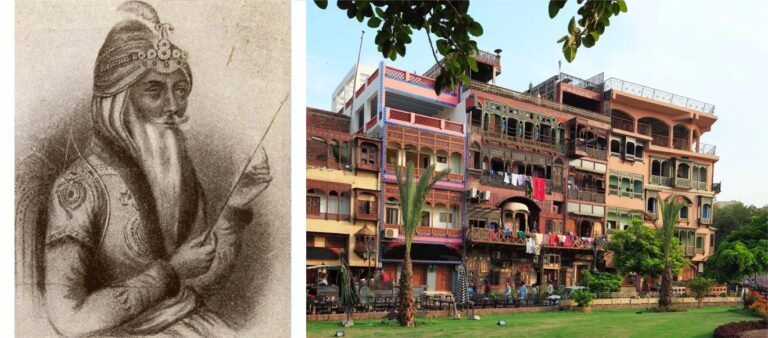![]()
Lahore’s Heera Mandi, the subject of Sanjay Leela Bhansali’s ‘Heeramandi’, has a storied past rooted in art and culture. This vibrant district, formerly known as Shahi Mohallah, flourished under Mughal patronage long before Maharaja Ranjit Singh’s arrival at the end of the 18th century. The Maharaja’s love story with a tawaif named Moran Sarkar is a testament to the area’s rich cultural tapestry. Here’s the epic story of Heera Mandi, tracing its journey from royal courts to its present-day reputation.
The Shahi Mohallah of the Mughals
Heera Mandi’s origins date back to the 17th century when it was known as Shahi Mohallah, or the royal neighborhood. Under Mughal rule, the area became a cultural hub visited by princes and nobles. Women from Afghanistan and Uzbekistan were brought here to entertain the royal court, mastering classical kathak, mujra, thumri, ghazal, and dadra. These women, known as tawaifs, were highly skilled in music and dance, and wielded significant influence and financial independence.
Despite the prohibition of prostitution in Islam, Shahi Mohallah thrived under Mughal patronage. Lahore, one of the three power centers under Mughal rule alongside Delhi and Agra, reflected its opulence in Shahi Mohallah. However, after the death of Aurangzeb in the early 18th century, the Mughal empire declined. The Afghan invasion of Lahore in 1748 by Ahmad Shah Durrani further reduced Shahi Mohallah to a hub of prostitution, a situation that persisted until Maharaja Ranjit Singh’s conquest of Lahore in 1799.
Maharaja Ranjit Singh and Moran Sarkar
Ranjit Singh, a young chieftain of the Sikh Shukerchakias, seized Lahore at 17 and declared himself the Maharaja of Punjab in 1801. Known for his military prowess, Ranjit Singh was also a patron of beauty and art, drawing him to Shahi Mohallah.
In March 1802, Ranjit Singh met Moran Sarkar, a 12-year-old Muslim dancer renowned for her beauty and artistry. Captivated by her performance, the Maharaja began spending significant time with her, much to the dismay of his elite and religious companions. Despite societal backlash, Ranjit Singh married Moran and never asked her to convert to Sikhism. He even built a mosque in her honor and minted coins bearing her name, elevating her status beyond that of a concubine.
Transformation into Heera Mandi
Ranjit Singh’s conquest revitalized Shahi Mohallah. His Prime Minister, Hira Singh Dogra, envisioned the area as an economic hub and established a grain market there. This market, initially called ‘Hira Singh di Mandi’ (Hira Singh’s market), gradually became known as Heera Mandi. Many believe the name also reflects the unparalleled beauty of the women in the area.
After Ranjit Singh’s death and the British colonization of Punjab in 1849, the cultural aspects of Heera Mandi diminished. The British, influenced by Victorian-era conservatism, equated cultured tawaifs with common prostitutes, pushing them into clandestine sex work and stripping away the artistic essence of Heera Mandi.
The Legacy and Decline of Heera Mandi
Despite these challenges, Heera Mandi continued to produce famous Pakistani cinema stars like Noor Jahan, Mumtaz Shanti, and Khurshid Begum. Today, Heera Mandi is a shadow of its former self. By day, it operates as a regular market, but at night, it turns into a red-light district. The romantic tales emerging from Heera Mandi now pale compared to the storied love of Maharaja Ranjit Singh and Moran Sarkar.
A Cultural Hub Turned Red-Light District
The courtesans of Heera Mandi were once akin to royalty, shaping the cultural landscape of colonial India. They were businesswomen, intellectuals, and patriots, deeply involved in the arts and society.
Heera Mandi and the Freedom Struggle
Amidst their artistry and cultural influence, many tawaifs of Heera Mandi played a significant role in the Indian freedom struggle against British colonial rule. The courtesans used their influence and resources to support the freedom fighters, often providing financial aid and safe havens for revolutionaries. Their salons became centers for political discourse and planning, highlighting their role not just as entertainers but as key figures in the resistance movement.
The British Raj’s Impact
The British Raj, however, transformed Heera Mandi into a “Bazaar-e-Husn” (Market of Beauty), reducing the esteemed tawaifs to sex workers. The British officers, unfamiliar with the cultural significance of tawaifs, viewed them through the lens of Victorian morality, which did not distinguish between courtesans and common prostitutes. This misinterpretation led to the gradual decline of Heera Mandi’s cultural heritage.
The Enduring Legacy of Heera Mandi
Following the decline of Heera Mandi, many tawaifs entered the entertainment space, acting and dancing in movies in the Indian and Pakistani film industries. Subsequently, a number of music and dance studios opened up in Heera Mandi, and over time, the historic region witnessed the rise of food streets, restaurants, and shops. Today, Heera Mandi is only a shadow of the vibrant, thriving cultural hub it used to be. However, the rich history of the diamond market remains etched in every corner of the walled city.
Sanjay Leela Bhansali’s series on Netflix brings this captivating story to life, blending fiction with the historical essence of Heera Mandi. As Heera Mandi evolves, its legacy as a cultural beacon persists, even if only in memory.
Watch the video here.
Reference:







